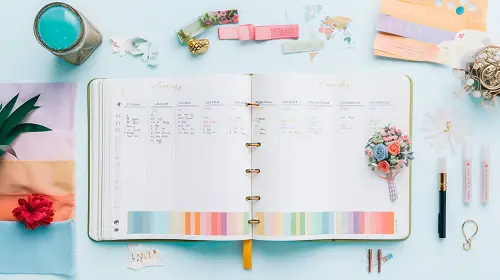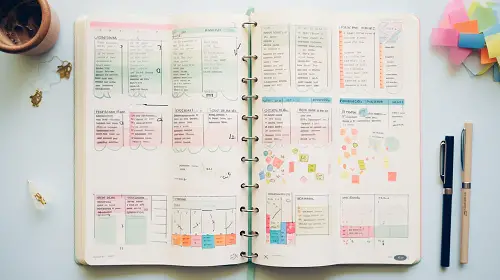In the world of planning and organization, two popular methods stand out: the bullet journal and the traditional planner. Both options offer unique ways to manage your time, tasks, and goals, but they have distinct differences that cater to different preferences and needs. In this article, we will explore the characteristics of each system and help you determine which one is the right choice for you.
Bullet Journal: The Customizable Powerhouse
The bullet journal, often referred to as “BuJo,” is a flexible and highly customizable system invented by Ryder Carroll. The core concept of bullet journaling is simplicity combined with personalization. It consists of using a blank notebook and transforming it into a personalized planner, diary, and creative outlet.
Key Features of a Bullet Journal
- Flexibility: One of the main advantages of a bullet journal is its flexibility. You have complete control over the layout, sections, and designs of your journal. You can adapt it to your changing needs and experiment with different trackers, collections, and layouts.
- Rapid Logging: The bullet journal relies on a simple shorthand system of bullets to represent tasks, events, and notes. This rapid logging method allows you to quickly jot down information and easily identify the type of entry at a glance.
- Collections: Bullet journals often include dedicated pages for collections, which are lists or trackers for specific themes or topics. You can create habit trackers, mood trackers, reading lists, and more, tailoring them to suit your interests and goals.
- Migration and Reflection: Bullet journaling encourages regular reflection and migration of incomplete tasks. At the end of each month or week, you can review your entries, migrate unfinished items to the next time frame, and reflect on your progress and priorities.
Pros of a Bullet Journal
- Infinite customization and personalization options.
- Versatility for combining planning, tracking, and creative outlets.
- Flexibility to adapt to changing needs and goals.
- Encourages mindfulness, reflection, and self-awareness.
- Provides a sense of ownership and creative expression.
Cons of a Bullet Journal
- Requires time and effort to set up and maintain.
- May not be suitable for those who prefer a structured format.
- Can be overwhelming for beginners due to the freedom of customization.
- May not have pre-designed layouts and templates for quick planning.
Traditional Planner: The Structured Organizer
The traditional planner, also known as a pre-printed planner or agenda, offers a structured format with pre-designed layouts and sections. These planners come in various sizes and designs, catering to different organizational styles and preferences.
Key Features of a Traditional Planner
- Pre-Designed Layouts: A traditional planner typically comes with pre-designed layouts, such as monthly calendars, weekly spreads, and daily pages. These layouts provide structure and guidance for planning your days, weeks, and months.
- Time-Specific Organization: Traditional planners often have designated spaces for recording appointments, deadlines, and time-specific tasks. They allow you to plan your schedule meticulously and keep track of important events.
- Easily Accessible Templates: With a pre-printed planner, you have instant access to various templates and sections designed for specific purposes, such as goal setting, habit tracking, and meal planning. This saves time on initial setup and provides a consistent structure.
- Convenience and Ease of Use: Traditional planners offer convenience as everything is already laid out for you. It’s as simple as filling in the information and checking off tasks. They are ideal for those who prefer a straightforward planning experience.
Pros of a Traditional Planner
- Ready-made layouts and templates for quick planning.
- Structured and organized approach to planning.
- Ideal for those who prefer a pre-determined framework.
- Convenient and time-saving setup.
- Offers a clear separation between different sections of planning.
Cons of a Traditional Planner
- Limited customization options.
- Less flexibility to adapt to changing needs and goals.
- May not cater to creative expressions or artistic endeavors.
- Might not provide space for additional collections or trackers.
- Less opportunity for reflection and migration of tasks.
Which One Is Right for You?
Choosing between a bullet journal and a traditional planner ultimately depends on your personal preferences, organizational style, and creative desires. Consider the following questions to help you make the right decision:
- Do you prefer structure or flexibility? If you thrive on structure and prefer pre-designed layouts, a traditional planner might be the best fit for you. On the other hand, if you enjoy the freedom to create and customize your planning system, a bullet journal will be more suitable.
- Do you enjoy artistic expression? If you find joy in adding artistic elements, doodles, or hand-lettering to your planning process, a bullet journal provides ample space for creativity. Traditional planners may offer limited opportunities for artistic expression.
3.## FAQ
1. What is the difference between a bullet journal and a traditional planner?
A bullet journal is a highly customizable system that allows you to create a personalized planner, diary, and creative outlet using a blank notebook. On the other hand, a traditional planner is a pre-printed planner or agenda with pre-designed layouts and sections.
2. Which one offers more flexibility?
A bullet journal offers more flexibility as you have complete control over the layout, sections, and designs. You can adapt it to your changing needs and experiment with different trackers, collections, and layouts.
3. Are traditional planners more suitable for structured planning?
Yes, traditional planners are more suitable for structured planning as they come with pre-designed layouts such as monthly calendars, weekly spreads, and daily pages. They provide a clear framework for planning your days, weeks, and months.
4. Can I incorporate artistic elements in a traditional planner?
While traditional planners may not offer as much space for artistic expression as bullet journals, you can still add creative touches like stickers, washi tapes, or small doodles to personalize your planner.
5. Which one is more time-saving for setup?
Traditional planners are more time-saving for setup as everything is already laid out for you. You simply need to fill in the information and start planning. Bullet journals require more time and effort to create the initial layouts and sections.
Remember, the right choice between a bullet journal and a traditional planner depends on your individual preferences and organizational needs. Consider your desire for customization, structured planning, artistic expression, and time-saving convenience to select the system that will best suit you. Happy planning!



